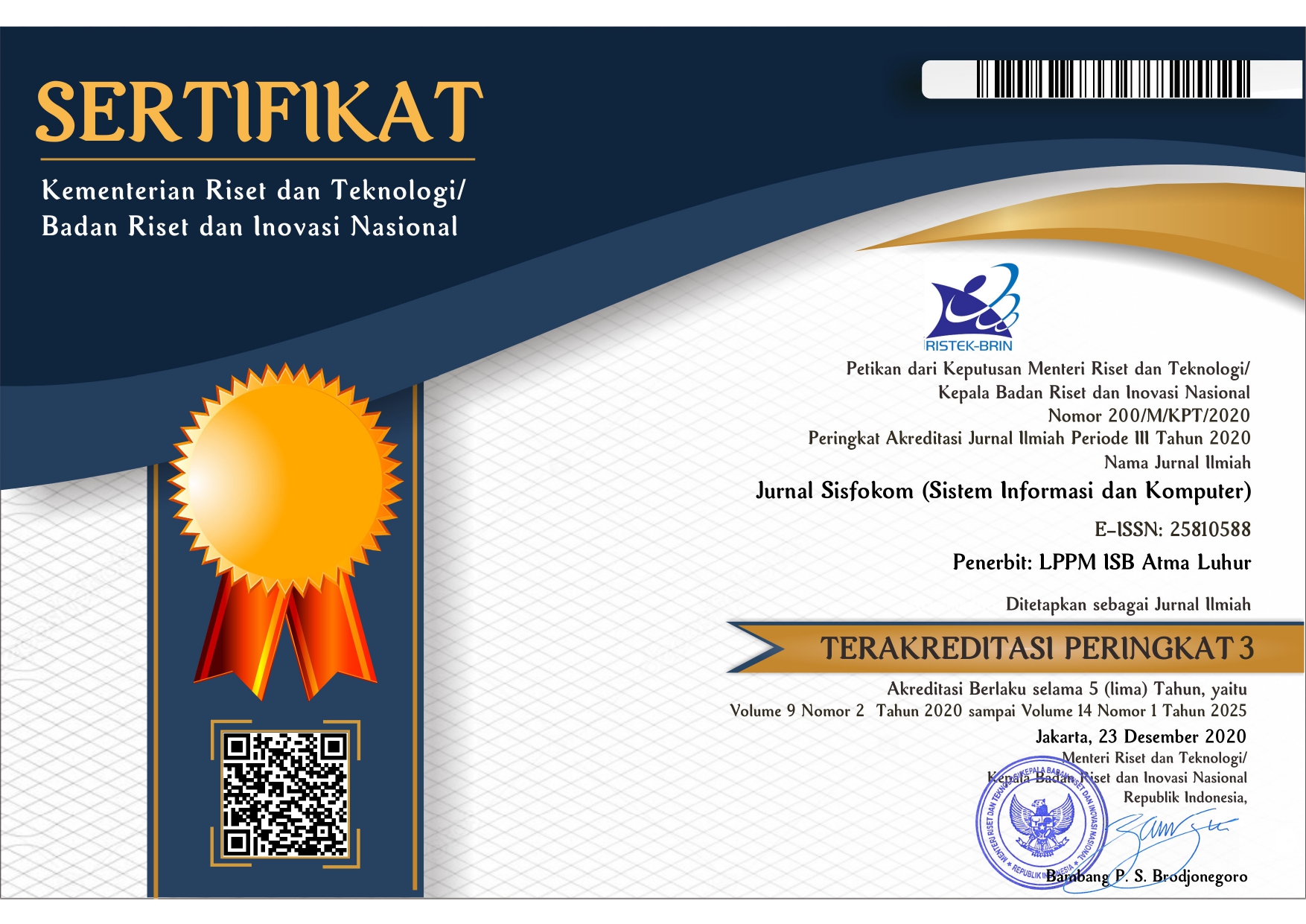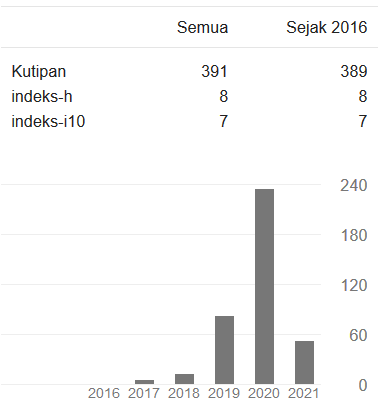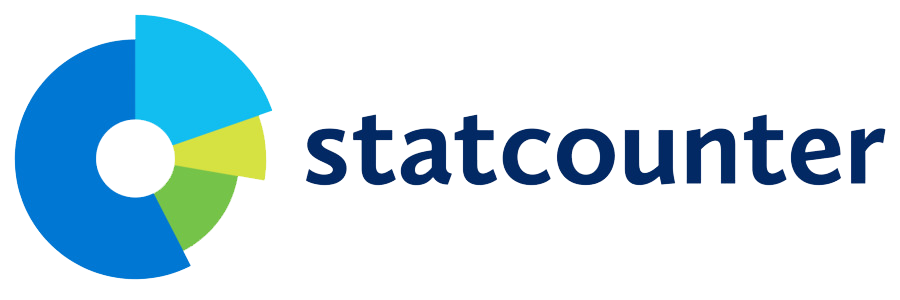DATA MINING MENGGUNAKAN ALGORITMA K-MEANS CLUSTERING UNTUK MENGETAHUI POTENSI PENYEBARAN VIRUS CORONA DI KOTA CIREBON
DOI:
https://doi.org/10.32736/sisfokom.v11i1.1316Keywords:
Data mining, K-means, Virus Corona, Kota CirebonAbstract
Virus corona merupakan wabah yang penyebarannya begitu cepat. Karena virus ini akan menyebar secara mudah melalui kontak dengan penderita. Salah satu daerah yang terdapak virus corona adalah Kota Cirebon. Untuk mengatasi penyebaran virus tersebut perlu mengelompokkan dareah yang berada di Kota Cirebon. Konsep data mining sangat cocok diterapkan untuk mengetahui penyebaran virus corona. K-means merupakan salah satu teknik data mining untuk melakukan pengelompokkan daerah yang terdampak virus corona. Parameter atau cluster yang digunakan adalah sebanyak 3 cluster yaitu tingkat penyebaran rendah (C1), tingkat penyebaran sedang (C2), dan tingkat penyebaran tinggi (C3), dengan 3 kriteria yaitu Kontak erat (KE), Suspek (S), dan Terkonfirmasi (T). Data yang diperoleh adalah 22 Kelurahan yang berada di Kota Cirebon dengan tingkat penyebaran virus corona. Hasil perhitungan menggunakan k-means didapatkan daerah yang terdampak virus corona dengan tingkat tinggi (C3) sebanyak 4 Kelurahan, tingkat sedang (C2) sebanyak 5 Kelurahan, dan tingkat rendah sebanyak (C1) 13 Kelurahan. Hasil dari penelitian ini menjadi salah satu bahan masukkan dan dapat menentukan skala prioritas bagi pemerintah Kota Cirebon dalam menangani virus corona.References
N. Dwitri, J. A. Tampubolon, S. Prayoga, F. Ilmi Zer, and D. Hartama, “Penerapan Algoritma K-Means Dalam Menentukan Tingkat Kepuasan Pembelajaran Online Pada Masa Pandemi Covid-19 di Indonesia,” Jti (Jurnal Teknol. Informasi), vol. 4, no. 1, pp. 101–105, 2020.
D. P. Sari, “Implementasi Algoritma K-Means Dalam Menentukan Tingkat Penyebaran Pandemi Covid-19 Di Sumatera Barat,” CBIS J., vol. 01, pp. 50–56, 2021.
A. Solichin and K. Khairunnisa, “Klasterisasi Persebaran Virus Corona (Covid-19) Di DKI Jakarta Menggunakan Metode K-Means,” Fountain Informatics J., vol. 5, no. 2, p. 52, 2020, doi: 10.21111/fij.v5i2.4905.
Dahlia Winingsih et al., “SIMBAS: Sistem Informasi Bantuan Jasa Pandemi Covid-19,” J. Sist. Cerdas, vol. 3, no. 2, pp. 123–132, 2020, doi: 10.37396/jsc.v3i2.61.
S. Handoko, F. Fauziah, and E. T. E. Handayani, “Implementasi Data Mining Untuk Menentukan Tingkat Penjualan Paket Data Telkomsel Menggunakan Metode K-Means Clustering,” J. Ilm. Teknol. dan Rekayasa, vol. 25, no. 1, pp. 76–88, 2020, doi: 10.35760/tr.2020.v25i1.2677.
R. Adelina Hutasoit, I. Parlina, S. Tunas Bangsa Pematangsiantar, A. Tunas Bangsa Pematangsiantar, and J. A. Jendral Sudirman Blok No, “Prosiding Seminar Nasional Riset Information Science (SENARIS) Penerapan Data Mining Dalam Mengelompokkanm Jumlah Usaha Berdasarkan Provinsi Menggunakan K-Means Clustering,” no. September, pp. 937–945, 2019, [Online]. Available: http://www.bps.go.id.
R. Yuliani, “Infotek : Jurnal Informatika dan Teknologi Penerapan Data Mining untuk Mengcluster Data Penduduk Miskin Menggunakan Algoritma K- Means di Dusun Bagik Endep Sukamulia Timur Infotek : Jurnal Informatika dan Teknologi Pendahuluan masalah kemiskanan belum bis,” vol. 4, no. 1, pp. 39–50, 2021.
G. Gustientiedina, M. H. Adiya, and Y. Desnelita, “Penerapan Algoritma K-Means Untuk Clustering Data Obat-Obatan,” J. Nas. Teknol. dan Sist. Inf., vol. 5, no. 1, pp. 17–24, 2019, doi: 10.25077/teknosi.v5i1.2019.17-24.
K. Fatmawati and A. P. Windarto, “Data Mining: Penerapan Rapidminer Dengan K-Means Cluster Pada Daerah Terjangkit Demam Berdarah Dengue (Dbd) Berdasarkan Provinsi,” Comput. Eng. Sci. Syst. J., vol. 3, no. 2, p. 173, 2018, doi: 10.24114/cess.v3i2.9661.
P. A. Jusia and F. M. Irfan, “Clustering Data Untuk Rekomendasi Penentuan Jurusan Perguruan Tinggi Menggunakan Metode K-Means,” J. IKRA-ITH Inform., vol. 3, no. 3, pp. 75–84, 2019.
Downloads
Published
Issue
Section
License
The copyright of the article that accepted for publication shall be assigned to Jurnal Sisfokom (Sistem Informasi dan Komputer) and LPPM ISB Atma Luhur as the publisher of the journal. Copyright includes the right to reproduce and deliver the article in all form and media, including reprints, photographs, microfilms, and any other similar reproductions, as well as translations.
Jurnal Sisfokom (Sistem Informasi dan Komputer), LPPM ISB Atma Luhur, and the Editors make every effort to ensure that no wrong or misleading data, opinions or statements be published in the journal. In any way, the contents of the articles and advertisements published in Jurnal Sisfokom (Sistem Informasi dan Komputer) are the sole and exclusive responsibility of their respective authors.
Jurnal Sisfokom (Sistem Informasi dan Komputer) has full publishing rights to the published articles. Authors are allowed to distribute articles that have been published by sharing the link or DOI of the article. Authors are allowed to use their articles for legal purposes deemed necessary without the written permission of the journal with the initial publication notification from the Jurnal Sisfokom (Sistem Informasi dan Komputer).
The Copyright Transfer Form can be downloaded [Copyright Transfer Form Jurnal Sisfokom (Sistem Informasi dan Komputer).
This agreement is to be signed by at least one of the authors who have obtained the assent of the co-author(s). After submission of this agreement signed by the corresponding author, changes of authorship or in the order of the authors listed will not be accepted. The copyright form should be signed originally, and send it to the Editorial in the form of scanned document to sisfokom@atmaluhur.ac.id.









